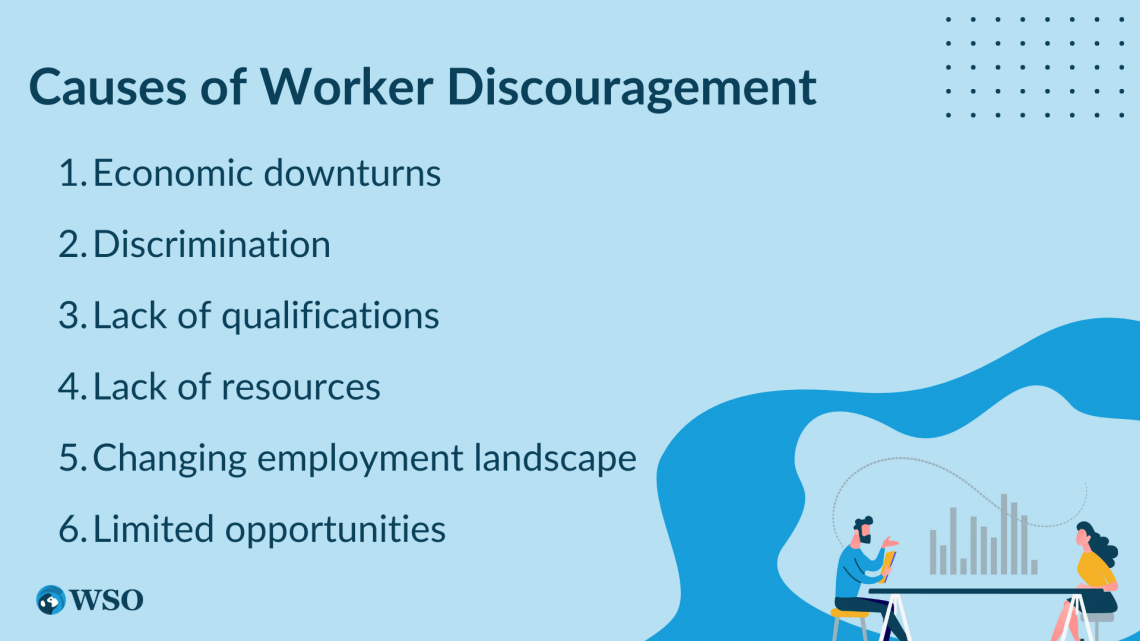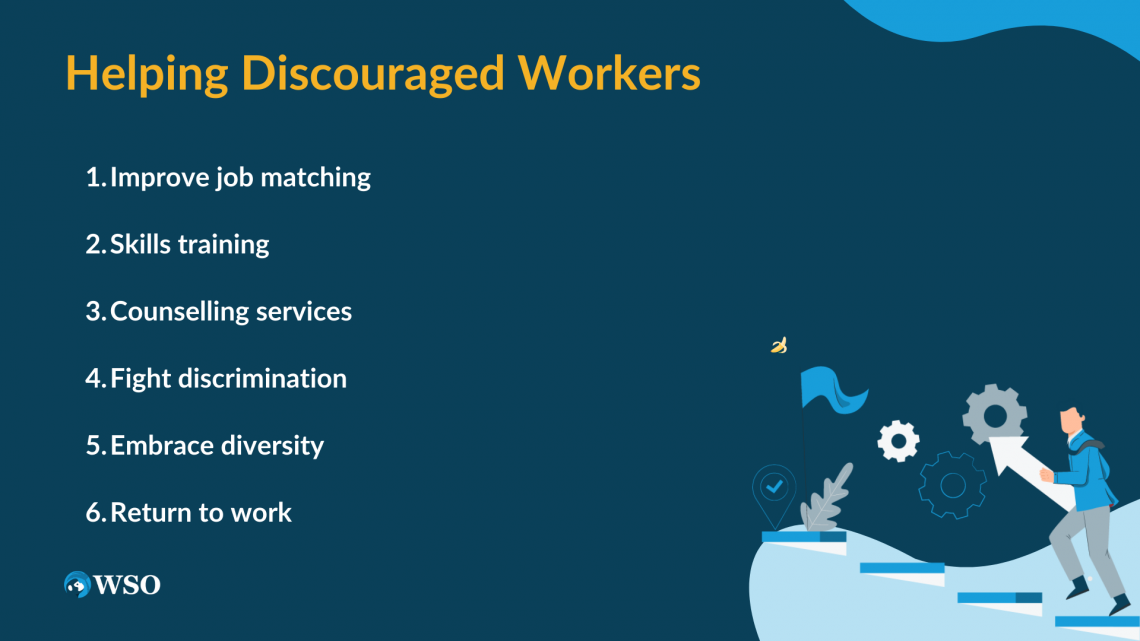Discouraged Workers
These are individuals who have given up on looking for a job but still have the desire and ability to work.
What Is a Discouraged Worker?
Potential labor force members who can and are willing to work but have given up job searching out of discouragement are labeled discouraged workers.

Though not considered unemployed in official statistics due to their lack of active job hunting, they still hold the potential to contribute to the workforce should they be presented with suitable opportunities.
Despite their desire to work, there are various rationales for why an individual would cease their job hunt. It's feasible that they've encountered countless rejections, thereby diminishing their self-assurance.
Alternatively, they might believe their skills to be outdated, having been unemployed for an extended period. Moreover, residing in a location where job prospects are scarce or facing bias based on gender, age, race, or disability could be possible deterrents.
Subsequently, familial or personal hardships may impede them from traveling to work or working full-time.

They not only lead to a weaker labor market, but their unemployment also creates a loss of human potential. It also negatively affects the worker's well-being and happiness. The effects are not limited to just the individual either.
The economy and society suffer as well. Research has demonstrated that unemployment can harm workers' self-esteem and general health by inducing great stress. These workers are a type of marginally attached workers.
Because they have given up the job search, they are not counted in the general labor force. Consider how this would impact an economy's productivity. Labor is a crucial factor of production, and when it diminishes, the economy's total output and GDP also decline.
As a result, discouraged workers represent inefficiency in the economy. There is labor that could be used, but it isn't being employed. As shown, it is in the government's and the people's best interest to reduce discouragement among workers.
Key Takeaways
- Discouraged workers are individuals who have given up on looking for a job but still have the desire and ability to work.
- They differ from unemployed workers, who are still actively searching for employment.
- The real unemployment rate includes them, although the official unemployment rate does not account for them.
- They may face various challenges, such as lack of skills, education, training, age discrimination, or disability.
- Employed or actively seeking employment individuals are measured by the labor force participation rate percentage.
- Discouraged workers can re-enter the labor force if they find new opportunities or incentives to work.
- The state of the economy and the labor market can be measured by observing the presence of discouraged workers.
Understanding Discouraged Workers
Finding employment becomes more daunting with each failed attempt. This is what makes a discouraged worker—the individual relinquishes their search after being blocked repeatedly.

According to the Bureau of Labor Statistics, the criteria for a discouraged worker include many elements:
- They are engaged in an active job search.
- They are actively looking for work.
- They possess a desire to work.
- They are available to work.
- They have not looked for work in the last month (four weeks).
- They have looked for work in the past year (12 months).
Their situation may leave them feeling depressed, frustrated, or hopeless. Barriers for women seeking employment may exist, including discrimination, health issues, lack of skills, or childcare responsibilities. These factors can make it challenging to secure employment.
Not included in the unemployment rate or labor force, they are the ones often not accounted for.
Looking for work or currently employed, the labor force comprises individuals in this category.
The unemployment rate is an economic indicator. It is defined as a percentage of the labor force. It consists of those who are without employment. These workers are neither employed nor looking for work. This is why they are excluded from these statistics.

Joblessness in the economy could be more extensive than what is reflected by the official unemployment rate. Being unemployed brings with it a lack of social interaction. These factors still affect individuals even after they've lost their positions. They may also become dependent on government assistance or family support to survive.
Another reason these workers matter is that they represent a loss of human capital and potential economic output. People build unique skills through experience, education, and training, collectively known as human capital.
When all available resources are fully utilized, an economy can produce a maximum amount of goods and services, known as potential output.
Discouraged workers possess human capital but are not utilizing it to contribute to the economy, resulting in wasted talent and skills that could otherwise generate value and wealth.
Economic Effects of Discouraged Workers
Discouraged workers, who are available for work but have given up searching for a job due to a perceived lack of opportunities, have several economic implications.

One key aspect is that they are not included in the official unemployment rate calculation, which leads to an incomplete representation of the actual unemployment situation.
Those marginally attached to the workforce and discouraged workers are not counted in the standard unemployment rate, leading to an inadequate depiction of the actual unemployment rate.
We must consider those who are underemployed too. This would help us get a more precise grasp of unemployment.
These workers represent a loss of human capital and potential economic output. Their skills and preferences could be utilized to increase the economy's production and income if they could discover suitable employment.
They would also pay taxes and spend more, boosting the government revenue and aggregate demand. The labor force participation rate, which measures the proportion of individuals actively seeking employment or currently employed, is a key metric affected by the presence of discouraged workers.

Lowering the labor force participation rate may occur when the economy is feeble and employment opportunities are rare, leading some workers to feel disheartened and leave the labor market.
Labor market slack has the potential to distort the true unemployment rate, as this measurement neglects to account for it. Therefore, the actual level of unemployment may exceed what is currently reported.
Due to economic growth, the number of laborers seeking a job may increase. In an economic boom, more job opportunities become available. Employment may increase because discouraged workers feel motivated to return to the labor force.
The labor force participation rate may just see an uptick as a possible outcome. The improvement in labor market conditions isn't reflected, which can give the appearance of a higher unemployment rate. Furthermore, the impact of discouraged workers extends beyond the economy.

Prolonged periods of joblessness can have negative social effects on their families, affecting individuals' motivation, self-worth, and overall well-being. Such circumstances can contribute to health issues like depression.
These workers may face discrimination or stigma from employers or society. They may also experience financial hardship. These factors can reduce their well-being.
Causes for Worker Discouragement
Discouragement from seeking work can arise from various reasons, such as lack of qualifications, discrimination, or economic downturns.

- Economic downturns: During the time of the Great Recession, for example, a lot of manufacturing laborers were laid off. This was due to their inability to adapt to technological advancements. Some gave up on finding a new job and became discouraged workers.
- Discrimination: Race, gender, and disability can also be grounds for discrimination. Some workers may face barriers or biases when applying for jobs or getting hired. Getting a fair opportunity or a decent wage may seem impossible to some. This can also lead them to stop looking for work and become discouraged workers.
- Lack of qualifications: Some individuals may not possess the necessary knowledge or qualifications for certain positions due to inadequate training or education. They may also lack the experience or credentials that employers look for.
- Lack of resources: Upgrading skills may seem necessary to some, while others may feel unqualified. To do this, time or money may not be available to them. This can also make them lose hope and become discouraged workers.These workers are missing out on income and benefits, personal fulfillment, and social interaction. They may experience low self-esteem or depression.
- Changing employment landscape: In the modern day, this issue is becoming more prevalent. This is due to the changing employment landscape. As more jobs require college degrees, those without college educations may face discouragement.
- Limited opportunities: The world's greater interconnectedness has connected countries' job markets globally. Outsourcing has become the norm for multinational corporations, reducing the number of available jobs.
In the modern landscape, helping discouraged workers return to labor has become a significant issue.
Helping Discouraged Workers
There are numerous ways to help these workers seek employment again. Many of these options require public policy change because this macroeconomic issue pertains to the national economy.

Here are some potential solutions:
1. Improve job matching
Providing more job opportunities and matching services connecting employers and job seekers would reduce unemployment.
The government can provide more support and guidance for job seekers. This can take the shape of career counseling, training programs, and mentoring and networking opportunities.
2. Skills training
By offering more training and education programs that help people upgrade their skills or learn new ones, we can ensure that workers always have the necessary skills to succeed in any employment landscape.
Note
Educators and trainers can help by providing more accessible and affordable learning opportunities that help workers update their skills and qualifications.
3. Counseling services
The government can provide more support and counseling services that help people cope with anxiety and depression. In addition, counselors and mentors can offer guidance and support that help workers overcome challenges and boost their confidence.
4. Fight discrimination
We can work to reduce discrimination and stigma against unemployed people and encourage them to keep trying for employment. Society can support this by showing more empathy and respect for these workers and recognizing their potential and value.
5. Embrace diversity
Encourage employers to adopt flexible and inclusive work arrangements that accommodate workers' needs and preferences. This can involve offering diverse work options and reducing barriers and biases faced by women, minorities, and other marginalized groups.
6. Return to work
Policymakers can create plans and programs to help these workers return to work. They can also incentivize companies to hire them. To promote employee retention, employers need to improve the quality of existing jobs. They can increase wages, benefits, flexibility, and security.
As shown, there are numerous ways to resolve worker discouragement. With the right public policy, we can work to enhance our economy.
Note
By improving labor force participation, we can grow standards of living nationally.
This can be done by increasing the total output of the economy. As more goods and services are produced, the country creates more wealth. This increase in standards of living can be applied to everyone.
The benefits extend to all citizens regardless of whether they are employed. For example, public goods and services improve lives without individual costs. As shown, reducing worker discouragement can benefit everyone in a nation.
Summary
Discouraged workers are a type of workers who are not part of the labor force. They have given up looking for work and are “discouraged.” There are numerous reasons why someone can become discouraged. It may be due to a lack of qualifications or simply job openings.

These workers may face additional challenges, such as a lack of training, which can be overcome through policy change. In contrast, employed or employment-seeking individuals are counted in the labor force participation rate.
Although these workers may eventually return to the labor force, the presence of these workers can signal the state of the economy and labor market. There are numerous ways for employers and the government to reduce this phenomenon.
Employers can embrace diversity, for example. By accommodating individual workers’ needs, employers can ensure that every laborer gets the opportunity to get meaningful work. With these solutions, we can reduce worker discouragement and pave the way to a brighter future.









or Want to Sign up with your social account?